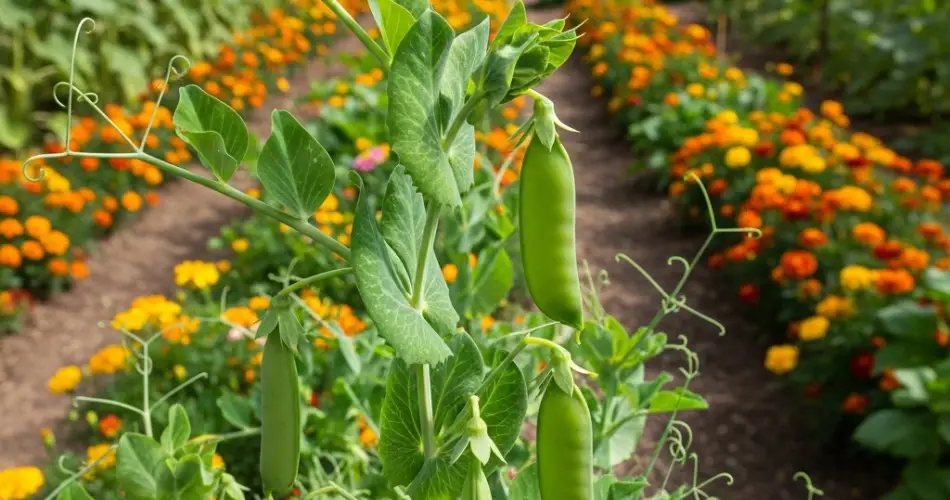Companion planting is a time-tested gardening method where different plants are grown close together to benefit each other. When it comes to peas—one of the most popular cool-season crops—companion planting can enhance growth, improve soil fertility, deter pests, and even maximize your garden space. However, not all plant pairings are beneficial. Some companions may stunt your peas’ growth or compete for resources.
Here’s a complete guide on which plants work well with peas and which ones to avoid, so you can make the most of your garden.
Why Companion Planting Matters for Peas
Peas are members of the legume family, which means they have a unique ability to fix nitrogen in the soil with the help of beneficial bacteria on their roots. This nitrogen-enriching trait can improve soil quality not only for peas but also for surrounding plants—making them excellent neighbors in the garden.
However, because peas are relatively delicate and shallow-rooted, they don’t compete well with aggressive growers. That’s why choosing the right companions is crucial.
Best Companion Plants for Peas
1. Carrots
Carrots and peas grow well together because they occupy different levels of soil. Carrots grow deeper while peas stay shallow, minimizing competition. Peas also add nitrogen to the soil, which supports healthy carrot growth.
2. Radishes
Radishes grow quickly and help loosen the soil, which benefits pea roots. Their strong scent may also help deter certain pests that might otherwise be attracted to peas.
3. Turnips and Beets
These root crops benefit from the nitrogen that peas fix in the soil. Since they don’t compete for vertical space or sunlight, they make excellent companions.
4. Lettuce and Spinach
These leafy greens enjoy the same cool growing conditions as peas. They grow low to the ground and can benefit from the light shade provided by taller pea plants, especially as temperatures rise.
5. Cucumbers
While it might seem unlikely, peas and cucumbers can grow well together if managed carefully. Cucumbers benefit from the nitrogen-rich soil left by peas, and both enjoy similar soil and sunlight needs. Trellising is essential to keep cucumbers from smothering pea plants.
6. Corn
Corn offers vertical support for peas to climb if you’re not using a trellis. This mimics the traditional “Three Sisters” gardening method, where crops grow cooperatively.
7. Mint and Other Aromatic Herbs
Mint (grown in containers to prevent spreading) and herbs like thyme and dill can help repel insect pests. Be cautious with mint, as it spreads aggressively.
8. Marigolds and Nasturtiums
These flowering companions attract beneficial insects and deter aphids, which are common pests of peas. Nasturtiums can also serve as a trap crop to keep pests away from your main vegetables.
Plants to Avoid Planting with Peas
Not all vegetables are good neighbors for peas. Some can hinder growth, attract pests, or create competition for nutrients and space.
1. Onions and Garlic
Members of the allium family—including garlic, onions, leeks, and shallots—are known to inhibit pea growth. They may release compounds into the soil that interfere with the root development of legumes.
2. Potatoes
Potatoes compete heavily for underground space and nutrients. They can crowd out pea roots and make it difficult to manage either crop effectively.
3. Chives and Scallions
Like onions and garlic, these aromatic plants can suppress pea growth and should be planted away from your legume beds.
4. Gladiolus (ornamental plant)
This flower may negatively impact peas, although the exact interaction isn’t fully understood. If you’re growing both vegetables and ornamentals, keep them in separate areas.
Tips for Successful Pea Companion Planting
-
Use a trellis to allow peas to climb and avoid smothering other low-growing companions like lettuce or spinach.
-
Plant early in the season while the weather is still cool. Most of the good companions for peas also enjoy spring and fall growing conditions.
-
Rotate crops annually to prevent disease and soil exhaustion. Even though peas enrich the soil, overplanting in the same spot can cause imbalances.
-
Mulch lightly around pea plants to suppress weeds and maintain soil moisture, especially if you’re interplanting with herbs or flowers.
-
Stagger plantings of fast growers like radishes or spinach to maximize the use of space around slower-growing pea vines.
Final Thoughts
Companion planting is a simple but powerful technique to help your peas grow better while enriching your garden ecosystem. By choosing the right plant partners—such as carrots, radishes, leafy greens, and certain flowers—you can boost your pea harvest, minimize pest problems, and build healthier soil. On the other hand, avoiding incompatible plants like onions, garlic, and potatoes will help prevent competition and growth suppression.
With thoughtful planning and regular observation, companion planting can turn your pea patch into a more productive and harmonious part of your garden.



